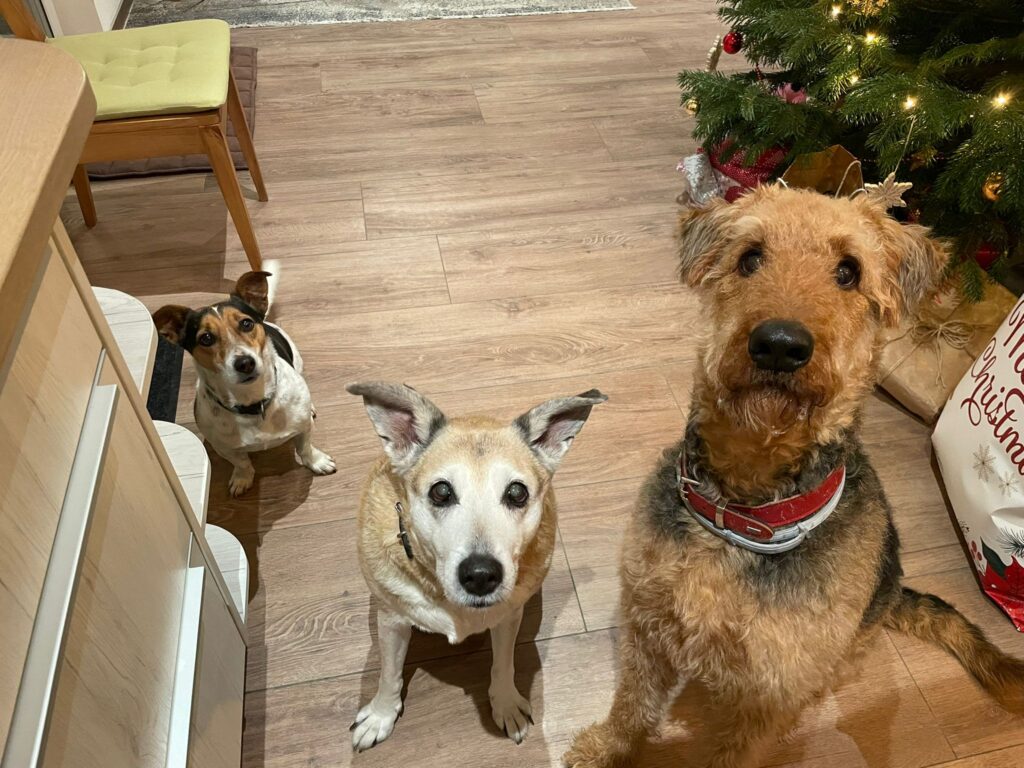Listen to Brenda tell the story
To improve your communication, take a cue from your pet. According to the organizational psychologist Adam Grant, one-third of women reported that their pets were better listeners than their partners. A jarring statistic—shocking, even. To put it bluntly: women often prefer their petter half.
The proliferation of cute cat and dog videos proves that Fluffy and Fido are wildly popular. But good listeners? They can’t even speak our language.
Part of the problem is how we define communication. Modern society focuses on speech, often to the detriment of body language. But this isn’t true for all phases of our lives: Babies are experts in body language. Janine Driver, President of the Body Language Institute, wrote a whole book about this topic.
My two-month-old baby understood a joke I made to my husband by watching my body language. When my husband saw me get up from the couch with my daughter to change her diaper, he looked at me quizzically and asked,
“What? Again, so soon?”
“Oh yes!” I said. “She already $/#* again!” making a fart noise.
To my complete surprise, my daughter giggled. She had been watching and listening to me closely and understood that the noise I made was meant to be funny. At two months, she didn’t understand my words, but she knew I was making a joke. I’ll never forget that moment. It taught me not to underestimate my kids’ intelligence.
It also gave me an unforgettable lesson in the power of body language.
It’s unfortunate that as we grow older, we focus increasingly on speaking and writing skills and forget the power of body language. This neglect is being aided and abetted by the explosive use of technology instead of in-person communication.
But never fear: it’s Rover to the rescue!
Or in this case: Batzi, Ginger, and Teddy, the canine companions of a friend of mine. Batzi is the Jack Russell terrier at the left in the title photo, a name that means “little squishy blob” in Bavarian dialect, a tongue-in-cheek moniker for this little muscly guy who routinely runs circles around the kitchen island and zooms across the fields surrounding the house at lightning speed, terrorizing any small animal he happens across.
What can we learn from the three polite pooches pictured here?
First of all, we need to pay attention to posture. All three dogs are sitting up perfectly straight. Their bodies are aligned to the front, indicating the focus of their attention. If you want to show someone you’re listening, sprawling out on the floor or hanging halfway off the side of your chair, swinging your legs, is not the way to go. Batzi and co. have figured this out. For us humans, this means we should sit down, sit up, and face our interlocutor.
Imagine if everyone in meetings did this. People might have to start putting actual content into their PowerPoint presentations. And who knows where that would lead!
Second, the eyes have it. Dogs are masters at using their eyes to convey a message. In this photo, they are visibly spellbound by the photographer, eyes wide open with anticipation. (This could be related to the fact that she is holding doggie treats in her hand, but we can’t be sure.)
So if you’re a human reading this, remember to look at the person talking to you. And keep looking. Don’t look out the window, even if someone happens to walk by and catches your attention. An exception can be made if the Loch Ness monster, a Yeti, or Bigfoot saunters past. In that case, grab your phone and take a picture. You can apologize later. Once again, the crystal-clear canine counsel is: Look at the person talking to you. (And please note my repeated clever alliterative use of the letter c.)
But be sure to avert your eyes intermittently to avoid the impression that you are staring. Gawking is just as bad as not looking at all.
Third, mouths are not just for talking. A closed mouth may not be saying anything, but it still sends a clear message: “I’m listening.” Note that all three dogs have buttoned their lips. Considering that dogs perspire through their mouths, this is not a given. But here they have their mouths closed to neaten their appearance. It’s what they’d do if they were standing at attention for roll call in the army. You don’t see those guys blowing bubbles, biting their lips—or drooling, as the case may be.
For us humans, it means to put a lid on it, as grandma would say. If you keep your mouth shut, it will keep you from interrupting. It will also keep the flies out, another tidbit of street smarts from my grandmother. Make that “farm smarts.”
Finally, hold still. The three tail-waggers in our photo are abstaining from one of their favorite communication activities to heighten their focus. No twitchy tails here. Instead, they’re intent on what their mistress is trying to tell them. They’re just…sitting.
For humans, this means just sitting still. It will help you zero in on the person talking to you.
However, I must warn you that imitating canine behavior only goes so far. Licking your genitalia, for instance, is usually not appreciated among humans, just in case that’s something you ever do (or are able to do, for that matter). I believe pooping on public lawns is also generally frowned upon. Not all of us are cute enough to get away with shit like that (if you’ll pardon the pun).
The easiest way to keep all these guidelines front of mind is to print out a picture of our three furry friends and stick it on your fridge as a reminder. Yip.
Brenda Arnold
